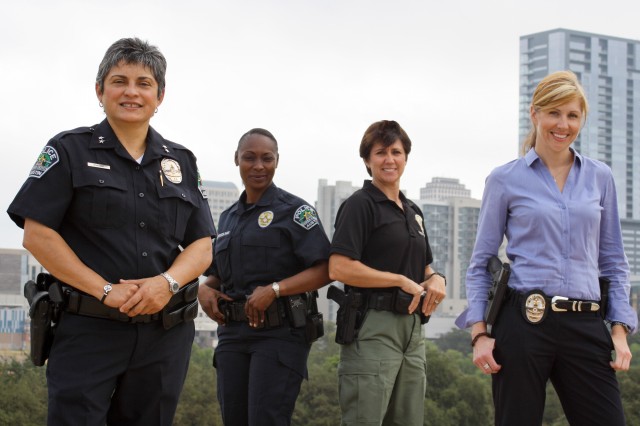Austin Police Diversity Training Program Feels Growing Pains

Austin Police Department has made efforts to reach out to more segments of the city’s population, including women. The Cultural Immersion Program was designed to address complaints that police mistreat minorities, who make up about half of Austin’s population. Photo by Jennifer Herber/Austin Police Department.
By Jhannet Sanchez
For Reporting Texas
A program that Austin police started a decade ago to better understand the city’s diverse cultural groups is making an effort to grow along with the city.
The Cultural Immersion Program, part of the police training curriculum, assigns cadets to interview residents from various ethnic and cultural groups to learn what they expect from their public servants. Three times a year, cadets report back to their training class on what they’ve found.
The department has sought to reach out to more segments of Austin’s population, but officers said getting community participation isn’t easy.
“The program has expanded over the years by first adding the Asian community several years ago, followed by the homeless community and now the bike-riding community,” said Officer Xavier Leyva, instructor for the program.
The program, created in 2003, was designed to address complaints that police mistreat minorities, who make up about half of Austin’s population. The city is about 35 percent Hispanic, 8 percent African American and 6.3 percent Asian American, according to the U.S. Census. Critics contend that the Police Department still is not sensitive to cultural differences and doesn’t communicate well with some parts of the community. Police counter that the community doesn’t always participate in its cultural training and outreach efforts, making it hard to work together.
Last year, APD received 226 code of conduct complaints, including 108 related to responsibility to the community. The code involves issues such as bias-based police profiling and discrimination and harassment. Responsibility to the community covers behaviors such as being courteous, having an impartial attitude and whether police properly identify themselves. The Cultural Immersion Program was conceived to reduce such complaints by training cadets in diversity and civil rights. Cadets must pass the program before they graduate.
In April, Leyva replaced Mike Burgeson as instructor for the program. Burgeson said the program is an important part of cadet training.
“It really does improve both the citizens’ and the APD’s relationships,” Burgeson said.
“It improves the citizens’ perspective,” Burgeson said, “because they see that we actually do care and we are taking the time and resources to find what we are doing right and what we are doing wrong.”
Some in Austin say police need to do more. Chas Moore, 26, a party promoter who has spoken out and led rallies against mistreatment of minorities in Austin, is among the critics.
“The biggest problem with the Austin Police Department is the overuse of excessive force,” Moore said. “APD needs more training on how to handle people of different cultures and backgrounds. It’s not only a race thing, it’s a race and class thing.”
Moore said the immersion program is not as inclusive as it should be.
“APD has a problem with certain demographic pools,” Moore said, “but most of the demographics that they are having a problem with are being pushed out of the Cultural Immersion Program.”
Burgeson said it’s true that the cadets can’t reach out to everyone. With larger training classes, it can take two days to hear all the presentations. Smaller classes are not able to reach out to every group. One 2010 cadet class had 78 members; the most recent class had only 19.
“So we’ve actually had people complain, asking why we are not researching their groups and we are researching others,” Burgeson said. “And it’s really because we don’t have the numbers necessary.”
Margo Frasier, head of the Office of the Police Monitor, said her office works to promote mutual respect between the community and law enforcement.
“Having a good relationship between the police and the community is important. The community helps the police,” Frasier said.
A good relationship requires good communication, Frasier said. While the immersion program is a good start, cadet training should put even more emphasis on police-community understanding.
“It’s good, and certainly better than nothing,” Frasier said. “But I think we spend, in general in the United States, way more time training police officers to shoot guns and fight with people than we do teaching them how to communicate with people. If we spent more time on the soft skills in communication and understanding, then you would be far less likely to use force.”
Burgeson conceded that the program has shortcomings.
“The sad truth is, we actually don’t get many people from the community coming in on this, even though we put it out in such a public forum,” he said. “That’s one of the things I want to make clear is we definitely want more people coming out and giving us their feedback.”
Moore questions the community outreach effort APD is making.
“The real question is, where is the community outreach?” Moore said. “Are you coming up to the kids of the demographics that you need to talk to? Are you going to East Austin and reaching out to the community? Where is that community outreach to the leaders and organizers of the community?”
When the department does organize community meetings, Moore said, they sometimes go about it the wrong way.
“When we do come out, for example the town hall meeting last summer, they show up with Tasers and guns,” Moore said. “I mean it’s OK to wear your uniforms, but what are we supposed to do in a town hall meeting when we are supposed to just be talking? It’s intimidating for the community.”
A police spokesperson said officers are required to carry their guns whenever they are in uniform.